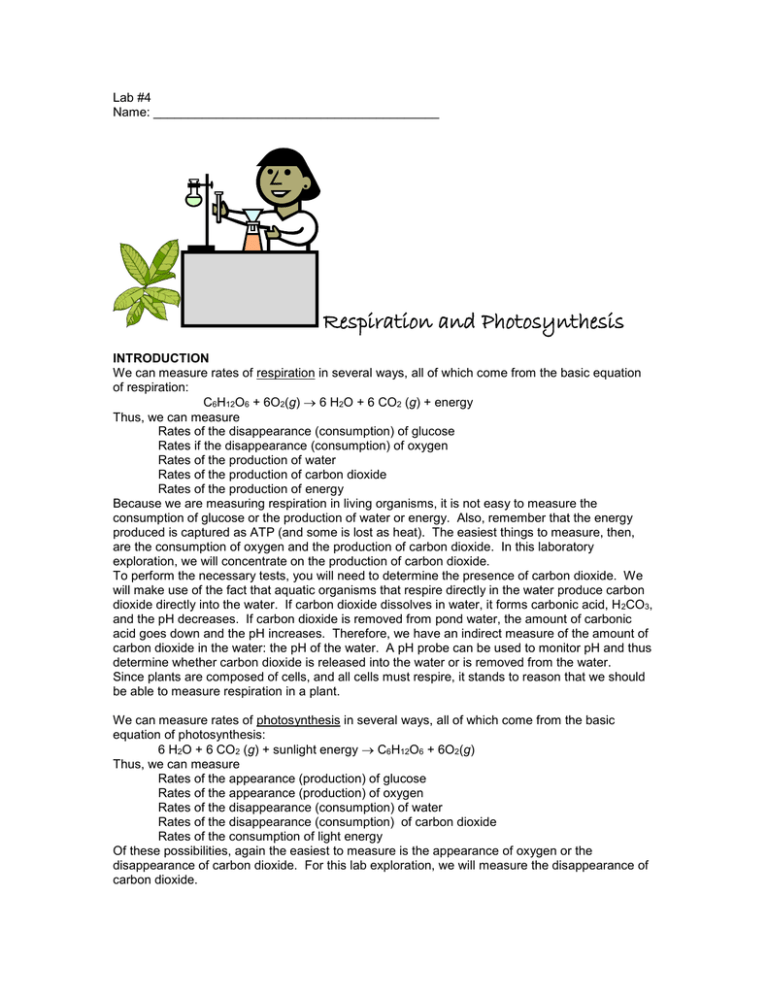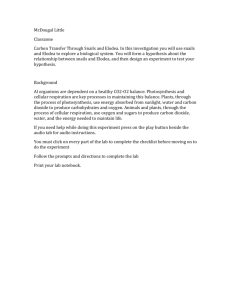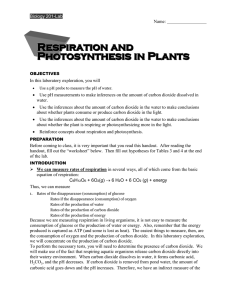Respiration and Photosynthesis
advertisement

Lab #4 Name: _________________________________________ Respiration and Photosynthesis INTRODUCTION We can measure rates of respiration in several ways, all of which come from the basic equation of respiration: C6H12O6 + 6O2(g) 6 H2O + 6 CO2 (g) + energy Thus, we can measure Rates of the disappearance (consumption) of glucose Rates if the disappearance (consumption) of oxygen Rates of the production of water Rates of the production of carbon dioxide Rates of the production of energy Because we are measuring respiration in living organisms, it is not easy to measure the consumption of glucose or the production of water or energy. Also, remember that the energy produced is captured as ATP (and some is lost as heat). The easiest things to measure, then, are the consumption of oxygen and the production of carbon dioxide. In this laboratory exploration, we will concentrate on the production of carbon dioxide. To perform the necessary tests, you will need to determine the presence of carbon dioxide. We will make use of the fact that aquatic organisms that respire directly in the water produce carbon dioxide directly into the water. If carbon dioxide dissolves in water, it forms carbonic acid, H 2CO3, and the pH decreases. If carbon dioxide is removed from pond water, the amount of carbonic acid goes down and the pH increases. Therefore, we have an indirect measure of the amount of carbon dioxide in the water: the pH of the water. A pH probe can be used to monitor pH and thus determine whether carbon dioxide is released into the water or is removed from the water. Since plants are composed of cells, and all cells must respire, it stands to reason that we should be able to measure respiration in a plant. We can measure rates of photosynthesis in several ways, all of which come from the basic equation of photosynthesis: 6 H2O + 6 CO2 (g) + sunlight energy C6H12O6 + 6O2(g) Thus, we can measure Rates of the appearance (production) of glucose Rates of the appearance (production) of oxygen Rates of the disappearance (consumption) of water Rates of the disappearance (consumption) of carbon dioxide Rates of the consumption of light energy Of these possibilities, again the easiest to measure is the appearance of oxygen or the disappearance of carbon dioxide. For this lab exploration, we will measure the disappearance of carbon dioxide. Since plants photosynthesize and respire, we will be measuring both respiration and photosynthesis by measuring pH changes under light and dark conditions. Based on what you know about photosynthesis and respiration, which would you expect to be more prevalent in a plant under light conditions? In dark conditions? What would happen to pH in light conditions? In dark conditions? These are questions you will address as part of this exploration. Worksheet a. Do plants respire in light? _______ b. Do plants respire in the dark?_________ c. Do plants photosynthesize in the light? ______ d. Do plants photosynthesize in the dark?___________ e. Plant cells respire to produce _____________. f. Plant cells photosynthesize to produce____ and _____ set of reactions called , which will be used in the _____________. g. Given your answer to the last question, what would happen to a plant cell that did not photosynthesize and why? ________________________________ h. Given your answer to the previous question, which should be faster, the rate of photosynthesis or the rate of respiration and why? i. Given your answer to the previous question, what do you predict will happen to the pH in the light, and why? PURPOSE AND HYPOTHESIS Propose the appropriate hypotheses and predictions for our experiments, testing whether photosynthesis and/or respiration occur in a plant in light and/or dark conditions. Also indicate which beaker you would use to test the prediction, and indicate which beaker is the control beaker. Remember that a prediction is an “If…then…” statement. APPARATI AND MATERIAL 8 large test tubes 400-ml beaker to rinse probe into distilled wash water in squirt bottle 4 sprigs of Elodea wax pencil well water scale 1 weigh boat 1 pH probe PROCEDURE 1. Obtain and label 8 large test tubes, and label 2 of them “Light-Control”, 2 “LightExperimental”, 2 “Dark-Control”, and 2 “Dark-Experimental”, and with your group name, using the wax pencil. 2. Obtain a pH meter, open it and turn it on to warm up. 3. Fill each tube with well water. 4. Obtain 4 large sprigs of Elodea (or other aquatic plant). Obtain enough to fill the water in the tube with plant. Pat the plants dry with a paper towel, weigh them and record the data in Table 1. 5. Place one sprig in each “Light-Experimental” tube, and in each“Dark-Experimental” tube. The sprigs should be under water. 6. Remove the cap on the pH probe. Rinse the probe thoroughly with distilled water (you may rinse into a sink or the 400-ml beaker). 7. Place the probe into a “Light-Control” tube and gently swirl briefly to allow water to move past the probe’s tip. When the reading stabilizes, or after 2 minutes, record the pH value in Table 1; do not wait longer than 2 minutes. Measure the pH of the other 7 tubes. Record the values in Table 1. 8. When all readings have been taken, rinse the pH probe with distilled water, replace the cap, and turn off the meter. 9. Place “Light-Control” and “Light-Experimental” tubes under light conditions in the light rack in the back of the room. One set (experimental and control) will be left for 30 minutes. The other set will be left for 60 minutes. 10. Place “Dark-Control” and “Dark-Experimental” tubes under dark conditions in the cabinet under your table. One set (experimental and control) will be left for 30 minutes. The other set will be left for 60 minutes. 11. After 30 minutes, measure pH (using the pH probe) for each of the first set of 4 tubes (light and dark conditions). Record the data in Table 1 below. 12. Repeat step 10. 13. After 60 minutes, measure pH (using the pH probe) for each of the second set of 4 tubes (light and dark conditions). Record the data in Table 1 below. 14. Clean up by returning the well water and Elodea to the Elodea container, and putting your beakers, wax pencil, squirt bottle and the pH meter back at the front of the room. Wipe up any spilled water, and throw away paper towels and the weigh boat. DATA AND OBSERVATIONS Calculate the change in pH (pH) for your organisms by subtracting the starting pH from the ending pH. Record your results in Table 1. You must correct for any changes that occurred to the pH of the water that were NOT the result of photosynthesis or respiration. Do this by subtracting the pH of the control beaker from that of the Elodea beaker. Record this "corrected pH" in Table 1. Divide the corrected pH for the Elodea Record your corrected pH/g data on data sheet on the overhead. Copy class data from the overhead to Table 2. Calculate the average corrected pH/g for each of the beakers and record in Table 2. On the same graph, graph the average corrected pH/g from BOTH light and dark data– the two conditions are “dark” and “light”. USE GRAPH PAPER (or a computer). Be sure to correctly label the x- and y-axes. Attach to this handout. Table 1: Raw Data Sample Weight (g) Expt. pH 1 Control pH 1 Expt. pH 2 Control pH 1 Expt. pH Control pH Corr. pH pH g Light – 30 mins Light – 60 mins Dark – 30 mins Dark – 60 mins Table 2. Corrected pH/g from the different class groups, and average corrected pH/g. Sample Group 1 Group 2 Group 3 Group 4 Group 5 Group 6 Group 7 Group 8 Average ElodeaLight 30 ElodeaDark 30 Elodea – Light 60 Elodea – Dark 60 DATA INTERPRETATION The “light” conditions: In the following table (Table 3), you should have already made predictions and indicated which is the experimental beaker and which is the control beaker. Now: Interpret the class data to support or reject the hypothesis. Explain your reasoning. How did you interpret your data to make the conclusion? If rejected, write a corrected hypothesis. Table 3. Hypothesis table about whether respiration rate or photosynthetic rate is greater in the “light” conditions. Experimental Control Test Beaker: Test Beaker: Reasoning (for your choice of "support" or "reject") Interpretation (circle one): support or reject? If rejected, a corrected hypothesis: The “dark” conditions: In the following table (Table 4), you should have already made a hypothesis, your reasoning for the hypothesis, and the prediction addressing the question of which would be greater, the rate of respiration or the rate of photosynthesis. Now: Interpret the class data to support or reject the hypothesis. Explain your reasoning. How did you interpret your data to make the conclusion? If rejected, write a corrected hypothesis. Table 4. Hypothesis table about whether respiration rate or photosynthetic rate is greater in the “dark” conditions. Interpretation (circle one): support or reject? Reasoning (for your choice of "support" or "reject") If rejected, a corrected hypothesis: QUESTIONS TO ANSWER: 1. Calculate what the corrected pH/g would have been if we could have kept the plant from respiring in the “light” conditions (i.e., in the absence of respiration, so that the plant was only photosynthesizing). 2. Why do we divide pH by the weight of the organism? 3. What was the purpose of the empty tubes in your experiment? If the pH changed in these tubes, what might have caused these changes? 4. Rigorous science demands that you test your hypotheses many times. Using what you know about photosynthesis, write an alternative prediction you could have used to test your hypothesis in Table 1, assuming you had available reagents and equipment. 5. Remember that photosynthesis and respiration both involve enzymes. Given what you know about enzyme activity, what effect do you think temperature would have on the rate of photosynthesis and respiration? At what temperature do you expect the enzymes found in Elodea to function optimally? 6. So… do plants both respire and photosynthesize in the light (yes or no)? TO TURN IN: This lab report is due on Thursday (7/20). Turn in the answers to all of the questions posed in the text above – use a separate piece of paper where necessary. Make sure all tables are filled in and a graph attached.





